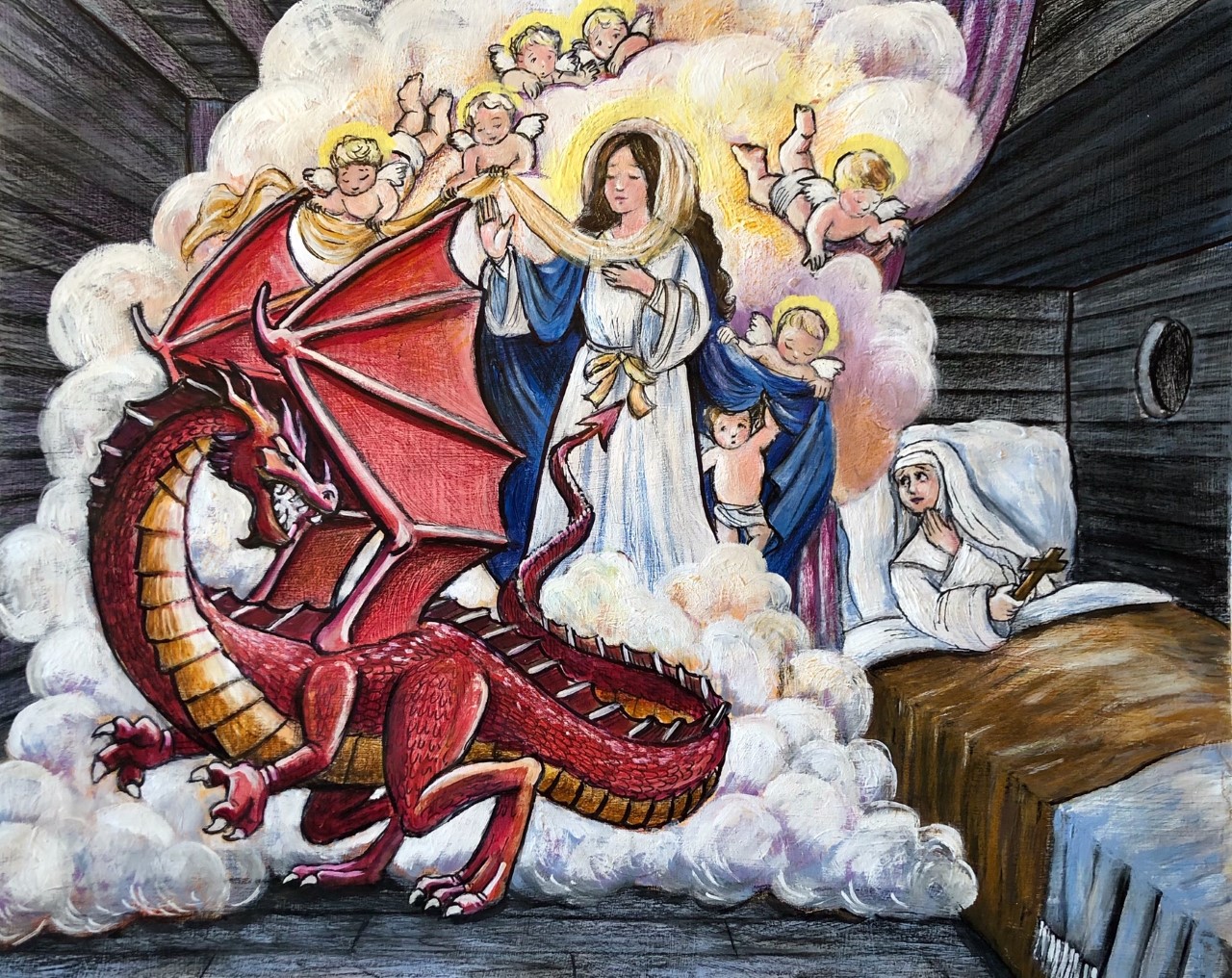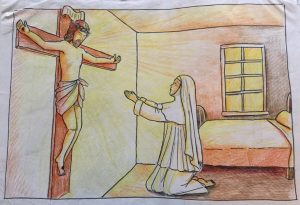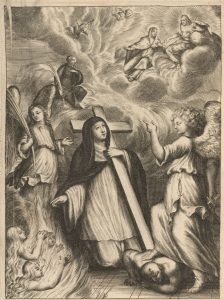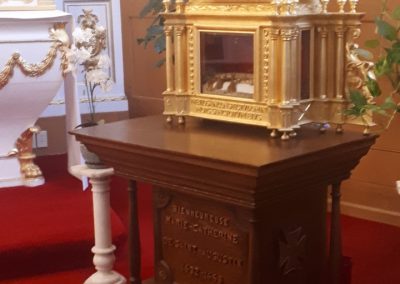Blessed Catherine of Saint Augustine
Youth of Blessed Catherine of St. Augustine:
Catherine was born on May 3, 1632, the feast of the Holy Cross, in St. Sauveur-le-Vicomte, France. From the age of three and a half,” she says in her Diary, “I had a very great desire to do God’s will […] I did not fail to ask my good mother often how to do God’s will. This forced her one day, when the Jesuit Father Malherbe was at home, to call me before him and say that I was importunate in asking what the will of God was, and how it should be done; and turning to me, she told me that I should make my requests to the Father, and that he would teach me better than she. So I asked everything that came to my mind concerning this matter; and I remember that one of the last questions was who is it that does the will of God well? The Father, on the occasion of a poor man who had just been brought in very ill, full of ulcers and covered with vermin, said to me: “My child, it is this poor man who does the will of God well, taking his evil with good heart as he does; for,” he added, “one does the will of God more surely in afflictions, humiliations and sufferings, than when one has everything to wish for. I asked him why this was so, and whether those who do not suffer would be damned, since they do not do God’s will as well as others? He told me no, and explained to me why the marks of God’s will were more certain in those who suffered than in others. His answer gave me such a vehement desire to suffer for the sake of God’s will, that I could not think of anything else but to suffer well from evil. (La vie de la Mère Catherine de Saint Augustin, Father Paul Ragueneau, page 23)
Mission to Canada and the mystical life:
In 1643, when she was eleven years old, she met Saint John Eudes who predicted that she would be a nun. The following year, Catherine and her sister knocked on the door of the Hôtel-Dieu de Bayeux with the intention of devoting themselves totally to God and his works in the Institute of the Hospitaller Sisters of St. Augustine. In 1648, when she was 16 years old, she volunteered to go and help the Hospitaller Sisters of the Hôtel-Dieu de Québec. She embarked for New France from the port of Bayeux. An epidemic of the plague made several sailors sick. Catherine was one of the few who volunteered to care for them, so much so that she herself became ill.
She had an important vision on her voyage to Canada. She tells us: “Being at sea to come to this country, I was sick with the plague to the end, and they were only waiting for the moment when I would die […] As I was therefore alone, thinking of God with peace and confidence, a large dragon came beside me. Its mouth was wide open and seemed to want to swallow me up. It had two claws raised up, as if to seize me as soon as I was judged. I was very much afraid at the sight of this monster of Hell: but what thought to make me die, was the clear and distinct sight of the number and quality of all my sins which appeared to me so horrible, that I myself was condemning myself to Hell at that moment […] addressing then the holy Virgin, I said to her with all the tenderness and the confidence of a child towards his good mother: hey well holy Virgin, it will be said then that a person, who after God has put all his trust in you, will be damned? As I finished speaking to her, I saw her appear as a Lady full of majesty and gentleness; the dragon fled at the sight of this holy Lady, and she said to me: “My daughter and my sister! You have wounded the heart of my Son and mine: if you want to die, do not be afraid, the devil cannot harm you, I am here to receive you. But you are still asked for the earth; what do you want?” “What I want, holy Virgin, you know it; may the will of your Son and yours be done in me? “”You will therefore still remain in the world; but with uncertainty of your salvation: think of it?” ”Alas my dear Mother! I have nothing to choose but what you will love best. Yet I felt a great struggle; but I could have no desire but for the will of God. She touched my plague with one finger, and when it was opened, my heart began to grow stronger… (The life of Mother Catherine of Saint Augustine, Father Paul Ragueneau, pages 39-40)

 Arrival in Quebec :
Arrival in Quebec :
She arrived in Quebec City in August 1648, and immediately began to care for the sick, both French and Amerindian. At that time, the Hôtel-Dieu of Quebec was only a small wooden cabin. The fear of attacks by the Iroquois, but also the harsh climate and the poverty were constant. To foster contact with the Amerindian patients, she also learned their languages.
She took as her spiritual director Father Paul Raguenau, a Jesuit who was very famous in New France and who wrote the first biography on Catherine. Barely a year after her arrival, Father de Brebeuf and Father Lalemant died as martyrs. She never saw them personally because they were near Lake Huron. Having an affection for Father de Brébeuf, since she had heard a lot about him, but also because he came from Normandy just like her, she decided to dedicate her life to him.
Especially from 1652 on, she will undergo many temptations against impurity, against the faith and against her fidelity to remain in Canada. In spite of this, she will have many visions of Our Lord, Our Lady, St. Joseph, St. Michael the Archangel, and many other saints. Heaven would give her Father de Brebeuf as her second spiritual director to support her in her many temptations, which were means chosen by the Good Lord to purify and sanctify her. She had visions of many saints, and in particular of Saint John of Brebeuf. He had been given to her from heaven as a director, but in complete subordination to her ordinary director. She saw Our Lord, the Virgin Mary, many angels and saints. Often souls in Purgatory appeared to her in their sufferings, asking for her help, even some of those who had died in France, before the news of their death reached Canada. She remained discreet about these visions. Only her spiritual director and Monseigneur de Laval (he arrived in Quebec City on June 9, 1659) were aware of her many visions. She did, however, have a policy concerning visions:
Do not desire visions:
“Her great Maxim was that to walk safely in the ways of God, one should apply oneself only to the practice of the solid virtues, humility, patience, obedience, charity, meekness, and conformity to the wills of God; since this is what Jesus Christ recommended to us only […] and she noticed very well that the Apostles, returning one day from the Mission, and wanting to rejoice with Jesus Christ that they had driven out the devils in his name, this good Master had warned them that it was not of these brilliant things that they should rejoice; but that their names were written in Heaven in the Book of Life and the Predestined; […] She added that whoever desires these extraordinary things, which often have more brilliance than solidity, exposes himself to the danger of losing humility, and of being easily deceived by the devil, who transforms himself into an angel of light, and who already has a great entrance into the souls of those who esteem too much these things, visions, apparitions, revelations, gifts of miracles; who desire them for themselves and do not challenge them; and who should rather consider themselves unworthy of them” (C.f. Father Paul Ragueneau, La vie de la mère Catherine de Saint-Augustin, third book : Her Life Obsessed with Demons, and Possessed of God, chapter 3, pages 103-104).
Saint Mary of the Incarnation wrote to her son about Blessed Catherine of Saint Augustine: “My dear son, these virtues are greater than miracles. Indeed, their excellence is such that when she died, no one in the community knew that she was an extraordinary being, not even her superior; only Monsignor (de Laval) and his spiritual director had this knowledge”. Catherine was so detached from the judgment of men that she liked to say: “Good God! Since we are only what we are before God, why do we seek to appear otherwise to men?
Important Vision: The Earthquake of 1663:
The alcohol trade breaks out like a plague in New France. Because of this, all the work of the missionaries began to collapse, because the Amerindians no longer wanted to listen to them, thinking only of alcohol. In 1662, Bishop de Laval decided to return to France to appeal to the king’s authority. In the meantime, Sister Marie-Catherine de St-Augustin saw Our Lord extremely angry. The earthquake began on February 5, 1663. There will be several tremors which will spread out over 7 months. The trade of brandy broke out like a plague in New France. The bishop of Laval decided to return to France to appeal to the authority of the king.
One day, Sister Marie-Catherine of Saint Augustine saw Our Lord very angry, so she prayed for the conversion of the guilty and increased her penances. But this was not enough to fully appease the holy wrath of God. On February 5, 1663, the astonishing earthquake that struck all of Canada and lasted seven long months began. God granted Sister Marie-Catherine a vision of the earthquake in Canada before it happened, in order to inspire her to pray and offer herself as a holocaust for the sins of the people. During the earthquake, she offered herself as a burnt offering. Finally, God was touched and allowed all the people to be converted and despite the violent earthquakes of 6.9, there was no loss of life.
 She wrote: “On February 5, having offered my devotions for souls in mortal sin, I asked the first Martyrs of Japan of the Society of Jesus, whose feast day was being celebrated, to apply them themselves, according to what would be more to the glory of God. At that time, I had a considerable premonition, and an infallible assurance, that God was ready to punish the country for the sins committed there, especially for the contempt they had for the Church. It seemed to me at that time that God was very angry. I could not help wishing for this punishment, whatever it might be; for I had no idea at the time what it might be. In the evening, at the same moment that an earthquake began, I saw in my spirit four demons, who occupied the four sides of the neighbouring lands, and shook them strongly, as if they wanted to overthrow everything; and without doubt they would have done so, if a superior power, which gave a kind of impulse to everything, had not put an obstacle to their will. Then the demons told me that they would do their best to continue this overthrow, that there were many people afraid, and that fear made them turn to God, and think of their conscience; but that they would make sure that it would not be of much use to them.
She wrote: “On February 5, having offered my devotions for souls in mortal sin, I asked the first Martyrs of Japan of the Society of Jesus, whose feast day was being celebrated, to apply them themselves, according to what would be more to the glory of God. At that time, I had a considerable premonition, and an infallible assurance, that God was ready to punish the country for the sins committed there, especially for the contempt they had for the Church. It seemed to me at that time that God was very angry. I could not help wishing for this punishment, whatever it might be; for I had no idea at the time what it might be. In the evening, at the same moment that an earthquake began, I saw in my spirit four demons, who occupied the four sides of the neighbouring lands, and shook them strongly, as if they wanted to overthrow everything; and without doubt they would have done so, if a superior power, which gave a kind of impulse to everything, had not put an obstacle to their will. Then the demons told me that they would do their best to continue this overthrow, that there were many people afraid, and that fear made them turn to God, and think of their conscience; but that they would make sure that it would not be of much use to them.
Two or three days later, being in front of the Blessed Sacrament, I felt inwardly invited to listen and to see? At first, I was a little disturbed; the voice and the presence of the one who spoke to me, even though it was not visible, gave me a great fear, because of His Majesty. Nevertheless my spirit calmed down, and although I was in a respectful fear, my heart possessed a deep peace. It seemed to me that Saint Michael was the one who was speaking to me: Here is what he first made me hear. Loquimini ad cor Ierusalem, et ad vocate eam, quoniam completa est malitia eius, dimissa est iniquitas illius. He carried in his left hand three arrows, and in his right hand a balance: on the arrows was written, Quis ut Deus? (Who is like God?) And the same motto seemed to compose a kind of clothing for him, the arrows were ready to be shot; one of the basins of the balance was filled, and as if filled with the previous words of the Prophet Isaiah. The other was almost empty, and only a vapor could be seen in it. I was told that these arrows were three kinds of punishment for three kinds of sins, which are common in this country; impiety, impurity, and lack of charity, especially in detractions and disunions. I begged the Angel to have a little more patience, and not to throw his arrows so soon. He said to me: Deus non irridetur (one does not make fun of God). I said to him, “Will God forget his great mercies? Let him punish me, who have drawn his wrath on this poor country; let him forgive the others. I was not given any other answer, except that I should read the writing on the scales carefully. I remained strangely touched that God was so irritated; and my heart was in a great desire to be able to appease him. I have never conceived so well what it is that sin is, as at that time. How little faith there is, and how little one understands what God is! (C.f La vie de la Mère Catherine de Saint Augustin, Père Paul Ragueneau, pages 145-147)
Life of suffering:
Father de Brebeuf announces, in a vision, that the demons have obtained from God that she no longer experiences any extraordinary supernatural help. And, at the same time, a troop of demons enters in her to torment her. She will undergo many obsessions (One distinguishes between temptation, vexation, obsession (manifested mainly by a certain control over the imagination) and possession). She will undergo many attacks that she will constantly offer for the conversion of sinners and for the liberation of souls in purgatory. She also obtained the conversion of Mr. de Mésy, who was giving free rein to the alcohol trade.
Spiritual dryness: Throughout her mystical life, she also suffered many spiritual drynesses. Padre Pio used to say that the closer one gets to God, the further away one feels from Him. The reason for this is that God wants us to detach ourselves from a sensitive and selfish love for Him. He wants us to love him for what he is and not only because he gives us benefits. Our Lord explains to her why she feels bitterness in loving God: “Do not be surprised that the sweetness of my love turns to bitterness in you, for it is only to bless you with more love. The cross will be your share, and peace will possess your heart” (Father Paul Ragueneau, La vie de la mère Catherine de Saint-Augustin, third book: sa vie obsédée des démons, et possédée de Dieu, chapter 1, pages 101). God wants to keep us humble
Her death:
 On April 20, 1668, she was seized with a spitting of blood. She was seized with a fever and a great pain in her chest. Her illness lasted 18 days. On May 7, at 3 o’clock in the morning, her pains suddenly left her. She believes herself cured. She intones the Te Deum, then asks for food. She then had a vision in which God revealed to her that he would come for her soon. Here is what her Mother Superior says about her death: “For, suddenly recovering, and making full use of her senses, she said in a free and intelligible voice, speaking to God: I adore your divine perfections, O my God; I adore your divine justice; I surrender myself to it with all my heart. Then, turning to the community, with a very joyful face and a revival of strength that seemed to us quite extraordinary, she asked what time it was. We told her that it was three o’clock in the morning. That’s fine, she told us, between five and six o’clock there will be a change in our affairs. But in the meantime, you see me cured; I have just been told that all my worries are over, that everything is done, and that there is no more suffering for me. (C.f. Mother Saint-Bonaventure of Jesus, superior of the Hôtel-Dieu de Québec, on the occasion of the death of Marie-Catherine de Saint-Augustin). Then, after saying this, she asked for food, to show that she was completely recovered. After eating, she sang a Te Deum with the nuns. Then she asked them to let her rest. She said, “I would like to lie down to sleep. Please let me rest, for I am exhausted from last night’s work. All withdrew, except the nurses, who took their places beside the patient’s bed,-the patient herself sleeping, apparently like a little child; her face was suffused with a slight redness, which suggested that she was returning to her natural condition. In the space of half an hour, during which she was observed very closely, it did not appear that she was breathing in the least. As we feared to wake her, we did not speak to her; but the nurse, placing her hand over the patient’s mouth, found that she was not breathing. This is how this beautiful soul took flight to heaven. Her face remained like that of a person in contemplation. (C.f. Mother Saint-Bonaventure de Jésus, superior of the Hôtel-Dieu de Québec, at the death of Marie-Catherine de Saint-Augustin).
On April 20, 1668, she was seized with a spitting of blood. She was seized with a fever and a great pain in her chest. Her illness lasted 18 days. On May 7, at 3 o’clock in the morning, her pains suddenly left her. She believes herself cured. She intones the Te Deum, then asks for food. She then had a vision in which God revealed to her that he would come for her soon. Here is what her Mother Superior says about her death: “For, suddenly recovering, and making full use of her senses, she said in a free and intelligible voice, speaking to God: I adore your divine perfections, O my God; I adore your divine justice; I surrender myself to it with all my heart. Then, turning to the community, with a very joyful face and a revival of strength that seemed to us quite extraordinary, she asked what time it was. We told her that it was three o’clock in the morning. That’s fine, she told us, between five and six o’clock there will be a change in our affairs. But in the meantime, you see me cured; I have just been told that all my worries are over, that everything is done, and that there is no more suffering for me. (C.f. Mother Saint-Bonaventure of Jesus, superior of the Hôtel-Dieu de Québec, on the occasion of the death of Marie-Catherine de Saint-Augustin). Then, after saying this, she asked for food, to show that she was completely recovered. After eating, she sang a Te Deum with the nuns. Then she asked them to let her rest. She said, “I would like to lie down to sleep. Please let me rest, for I am exhausted from last night’s work. All withdrew, except the nurses, who took their places beside the patient’s bed,-the patient herself sleeping, apparently like a little child; her face was suffused with a slight redness, which suggested that she was returning to her natural condition. In the space of half an hour, during which she was observed very closely, it did not appear that she was breathing in the least. As we feared to wake her, we did not speak to her; but the nurse, placing her hand over the patient’s mouth, found that she was not breathing. This is how this beautiful soul took flight to heaven. Her face remained like that of a person in contemplation. (C.f. Mother Saint-Bonaventure de Jésus, superior of the Hôtel-Dieu de Québec, at the death of Marie-Catherine de Saint-Augustin).
For having offered her life for the Church and the salvation of New France, Marie-Catherine de Saint-Augustin is considered co-founder of the Church of Canada. Her remains are located in a reliquary in the chapel of the Hôtel-Dieu de Québec, 75 des Remparts street, Québec (Qc).
Sources:
RAGUENEAU, Paul. La vie de la Mère Catherine de Saint Augustin
Dom Guy-Marie OURY, L’itinéraire mystique de Catherine de Saint-Augustin


